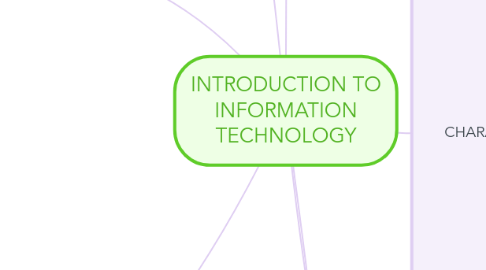
1. DEFINITION
1.1. The use of computer, hardware and software to store, retrieve and manipulate information
2. Disadvantages
2.1. VIOLATION OF PRIVACY
2.1.1. Other person might steal our personal and confidential reacords if they were not protected properly
2.2. PUBLIC SAFETY
2.2.1. We might be a victim to crime if we are exposing or sharing out photos, videos or other personal information publicly
2.3. IMPACT ON LABOUR FORCE
2.3.1. many employee might jobless if their skills have been replaced by computers
2.4. HEALLTH RISK
2.4.1. Prolonged or improper computer use can lead to health risks are computer addiction and technology
2.4.2. Behavioral health risks are computer addiction and techonology over load
2.5. IMPACT ON ENVIROMENT
2.5.1. computer manufacturing process and computer waste can couse pollution
3. Advantages
3.1. SPEED
3.1.1. Many computers can process billions or trillions of operations in a single second
3.1.2. Data, instruction, and information flows incrdibly fast speed.
3.2. RELIABILITY
3.2.1. The electronic components in computers are dependable and reliable because they rarely to break
3.3. CONSISTENCY
3.3.1. A computer with same input will produce the same result consistently
3.4. COMMUNICATION
3.4.1. Computer cam communicate wirelessly with other computer and allow users to communicate with one another
3.5. STORAGE
3.5.1. Computers can store enormous amounts of data and make this data available for processing anytime is needed
4. APPLICATION
4.1. EDUCATION
4.1.1. Learning Management System
4.1.1.1. Students can get their lecture note, answer quizzes and submit assigment by using learning management system
4.1.2. Computer Based training
4.1.2.1. uses computer generated visuals or environment for training such as flight simulator used by pilots before flying new plane or different of plane
4.2. FINANCE
4.2.1. Finance Investment System
4.2.1.1. Inventores buy and sell stock and bond online without using broker
4.2.2. Online Banking
4.2.2.1. To pays bills, track personal income and expenses, manage investments and evaluate financial plans
4.3. GOVERMMENT
4.3.1. E-FILING
4.3.1.1. online system for declaring tax
4.3.2. E-SYARIAH
4.3.2.1. online portal for providing infor
4.3.3. HRMIS
4.3.3.1. Online system for updating government employee information
4.4. HEALTH CARE
4.4.1. MEDLINE
4.4.1.1. Many web sites provide up-to-date medical fitness, nutrition or exercise information
4.4.2. COUNTER REGISTRATION
4.4.2.1. Hospitals &doctors use computers & mobile devices to maintain & access patient record
4.4.3. TELEMEDICINE
4.4.3.1. Health care professional in separate locations conduct live conference in the computer
4.4.4. TELESURGERY
4.4.4.1. Surgeon performs an operation on a patient who is not located in the same physical room as the surgeon
4.5. SCIENCE
4.5.1. VIRTUAL REALITY
4.5.1.1. Use of computer simulate a real or imagined environment that appears as 3D space.
4.5.2. COCHLEAR IMPLANT
4.5.2.1. Use of computer technology to help user in hearing problem
4.5.3. HAWK EYE OFFICIATING SYSTEM
4.5.3.1. Complex computer targeting system that is used to track the path of an object that is being developed for use in sports such as tennis and football
4.5.4. NEURAL NETWORK
4.5.4.1. A system that attempt to imitate the behavior of human brain
4.6. PUBLISHING
4.6.1. ONLINE NEWSPAPER & MAGAZINE
4.6.1.1. Allow user to get information easily by reading newspaper and magazine online
5. CATEGORIES OF COMPUTER$
5.1. SUPERCOMPUTER
5.1.1. Fastest and most powerful computer
5.1.2. Capable to process more than one quadrillion instruction in a single second
5.2. MAINFRAME
5.2.1. Large
5.2.2. Expensive
5.2.3. Powerful computer
5.2.3.1. handle hundred or thousands of connectors user simultaneously
5.3. PERSONAL COMPUTER
5.3.1. Can perform by itself
5.3.1.1. input
5.3.1.2. processing
5.3.1.3. output
5.3.1.4. storage
5.4. MOBILE COMPUTER & DEVICE
5.4.1. Mobile Computer
5.4.1.1. can carry anywhere
5.4.2. Mobile Device
5.4.2.1. can hold in your hand
5.5. EMBEDDED COMPUTERS
5.5.1. Component in a large product
6. CHARACTER OF COMPUTER
6.1. SUPER COMPUTER
6.1.1. Occupy a full room of equipment
6.1.2. Tens of thousands of processors
6.1.3. Extremely large storage
6.1.3.1. Example: 3.1PB
6.2. MAINFRAME
6.2.1. Partial room to a full room of equipment
6.2.2. Dozen of processors
6.2.3. Very large
6.2.4. Adadble storage
6.2.4.1. Example 4.6 TB
6.3. PERSONAL COMPUTER
6.3.1. Fits on desk
6.3.2. Single processor
6.3.2.1. (1.5 -2.5 Ghz)
6.3.3. Large
6.3.3.1. Example: 500 Gb
6.4. MOBILE COMPUTER
6.4.1. Fits on your lap or in your hand
6.5. MOBILE DEVICES
6.5.1. Smart phone size is fits in the palm of your hand or pocket size
6.6. EMBEDDED COMPUTER
6.6.1. Miniature
6.6.2. Mounted on a circuit board and then installed in a machine
7. COMPARE
7.1. SUPERCOMPUTER VS. MAINFRAIME
7.1.1. SUPERCOMPUTER
7.1.1.1. Its size more large
7.1.1.2. the cost is more expensive
7.1.2. MAINFRAIME
7.1.2.1. the size is smaller
7.1.2.2. the cost is cheaper
7.2. PERSONAL COMPUTER VS. MOBILE COMPUTER
7.2.1. PERSONAL COMPUTER
7.2.1.1. size is large
7.2.1.1.1. fit on desk
7.2.2. MOBILE COMPUTER
7.2.2.1. size is smaller
7.2.2.1.1. can carry from place to place
7.3. PERSONAL COMPUTER, MOBILE COMPUTER & EMBEDDED COMPUTER
7.3.1. PERSONAL COMPUTER
7.3.1.1. the largest
7.3.2. MOBILE COMPUTER
7.3.2.1. larger than enbedded computer
7.3.2.2. smaller than personal computer
7.3.3. EMBEDDED COMPUTER
7.3.3.1. the smallest among all types of computer

